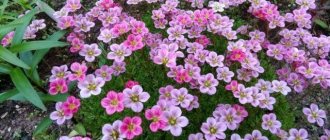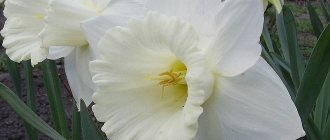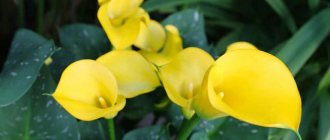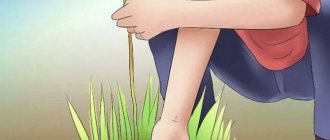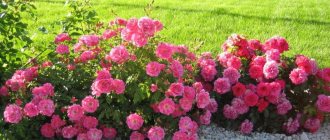A beautifully flowering ground cover plant that adorns the mountain slopes is saxifrage, a miniature representative of the green kingdom. Straight from the rocky slopes, saxifrage came to our gardens, taking root well in a variety of flower beds and, moreover, gaining unprecedented popularity among people interested in floriculture. The wide recognition of gardeners is based on several undeniable advantages of the flower: fast growth, unpretentiousness and, of course, natural beauty.
Delicate petals, colored white, pink or purple, thin miniature leaves, often reminiscent of moss. A thick green carpet of saxifrage can decorate any area, and its bright blooms will delight even the most sophisticated eye. But in order to successfully grow a beautiful ground cover in your flowerbed, it’s worth getting to know it better.
Saxifraga is a non-random name, being a literal translation of the Latin phrase saxifraga, consisting of two words (saxum - stone, rock and fragere - to destroy). The plant has other, less common, names, for example, gap-grass, femoral, dental.
This plant not only decorates gardens, it has a rich history. Here are some interesting and little-known facts about quarrying:
- Saxifraga oppositeifolia is a popular flower symbol in several territories, for example, the province of Nunavut (Canada), the city of Londonderry (Great Britain), and the province of Nordland (Norway).
- Saxifraga is a flower immortalized on the seal of the Japanese science city of Tsukuba.
- Some plant species are considered edible; in Southeast Asian countries, their leaves are fried in batter and eaten.
- Rupture-grass is also found in literary works; it is especially often mentioned by English poets and prose writers.
- The leaves of certain varieties are capable of secreting a substance such as lime, which gives their color a silver-gray tint.
- Traditional medicine considers some types of saxifrage to be medicinal plants that can heal colds and heart diseases, and help with urolithiasis. However, this perennial is not used in official medicine in any way.
According to the botanical classification, the genus Saxifraga (lat. Saxifraga) is one of the most numerous genera of the saxifrage family of the same name (lat. Saxifragaceae), uniting a group of herbaceous perennials. In addition, the genus contains annual and biennial species. All representatives of the genus have several common characteristics in common: small, most often round-shaped, leaves collected in a dense basal rosette and inflorescences consisting of small five-petaled flowers. Inflorescences, in this case, can be either paniculate or racemose. The height of saxifrage varies from 5 to 65 cm.
It is difficult to name the homeland of the unpretentious ground cover, because now the plant has spread throughout the globe: from the Japanese islands to the mountains of tropical regions of Africa. Under natural conditions, saxifrage can be seen in Russia; at least 125 species grow in the wild. Main distribution areas: Sakhalin, Kuril Islands, Caucasus Mountains. Some varieties are listed in the Red Book.
Most often, saxifrage can be found on rocky slopes. The plant prefers to live high in the mountains or on the foothills, especially in wooded areas or on the banks of streams. However, some species prefer wet meadows and valleys.
Plant card
There are more than 400 species of saxifrage in nature, but not all of them are suitable for growing in gardens and household plots.
Botanical description:
- class: perennial (less often annual) herbaceous plant, saxifrage family;
- height: 20-50 cm, depending on the type (short or tall);
- planting time: early summer, June;
- flowering time: summer, from June to August;
- location: sunny, open areas, partial shade is acceptable;
- flower size: small, up to 3 cm, form numerous umbrella or paniculate inflorescences;
- frost resistance is high, tolerates frosts down to -40 degrees.
The perennial does not require complicated care, tolerates cold well and is suitable for growing in northern regions.
We are creating special conditions: you will have to... move mountains!
Cushion-shaped saxifrages are inhabitants of mountains: crevices, caverns in stone, vertical walls. Their rigidity, hard protrusions, scaly structure, bluish color or powdery coating - all these are adaptations developed to reduce evaporation and withstand mountain solar insolation. The roots are designed in such a way that, on the one hand, they firmly hold the pillows in extreme conditions, and on the other hand, they are able to extract moisture and nutrients from the farthest crevices of the stone, in which it is most often stored.
But saxifrages are not used to the opposite: it is difficult for them to cope with excess moisture if it stagnates in the roots or around the root collar. They are not used to the summer heat: it is always cool in the mountains. So how can you please them?
Many quite winter-hardy saxifrages look amazing when planted in containers and require virtually no care other than watering. They are not afraid of prolonged freezing of the soil: in nature they often grow on cliffs completely devoid of snow. The place for saxifrage must be selected with special care; they simply will not grow in the garden bed.
Types and varieties of crops
Currently, gardeners cultivate about 80 species of plants, the lush flowering of which serves as a decoration for natural design. More often than others, alpine saxifrages take part in the decoration of the garden, covering the ground with a bright floral carpet.
Saxifraga arendsii PeterPan . Saxifraga Arends Peter Pan is a hybrid species that is classified as turfy saxifrage. A low-growing evergreen crop, reaching a height of 20 cm, the flowers are small, numerous, forming dense inflorescences of white, yellow, red and pink shades. The Arends variety Peter Pan blooms from May to June and tolerates frost well.
Another variety of Arends saxifrage is Purple Mantle or Purpurmantel. Its flowers have a bright dark pink color.
Variety Flamingo - height of an adult plant is 15 cm, flowers are pale pink.
Schneeteppich is a low-growing variety with small white inflorescences and dark green star-shaped leaves.
Bluetentheppich - up to 15 cm tall, bright red flowers.
Saxifraga paniculata . Paniculate saxifrage is characterized by its small height, up to 10 cm, and small flowers of a light yellow hue. The leaves are bright green with a white border along the edge. The crop blooms in June.
Saxifraga urbium . The shady or shady species grows up to 30 cm in height, has large, dark green leaves and small, up to 1 cm, white-pink flowers. The flowering period of shadow saxifrage is June-July. Some of its varieties are classified as low-growing (up to 8 cm) evergreen perennials and are grown in gardens and parks as a flower carpet.
Saxifraga with decorative panicles
This representative of the culture is not inferior in its characteristics to the previously presented species of Saxifraga. It is easy to care for and can withstand harsh climates and temperature changes.
The main positive quality is good tolerance of any soil acidity and soil composition. Decorative indicators also delight with their variety of colors and shapes:
- During the flowering period, a large number of miniature flowers of a red or purple hue appear on the base.
- Pale yellow inflorescences appear either later or simultaneously with the red flowers. They bring variegated colors and subtle contrast to the lush inflorescence.
The main feature of such a culture is the presence of original panicles, on which bright inflorescences are located.
Landing Features
When planting, it is enough to take into account the design of the planned garden. The culture is unpretentious and tolerates open sunny spaces and shady areas of the park equally well. The soil should be moderately fertile and well-drained; the plant cannot tolerate dampness. When planting, the soil can be fertilized with humus; coarse river sand, bricks, and pebbles are used as drainage.
Saxifraga reproduces:
- seeds;
- cuttings;
- layering;
- dividing the bush.
Propagation of crops by seeds
Important! Preparing seeds for planting involves stratifying them, when a container with planting material mixed with sand is placed in the refrigerator for 10-14 days. This treatment further promotes better germination and endurance of the plant.
After stratification, the seeds are sown in a container filled with a moist mixture of greenhouse soil, sand and peat. The container is covered with film and placed in a warm place for two weeks until germination.
Overgrown seedlings should be divided and transplanted into separate pots; the crop should be planted in open ground no earlier than June. Small depressions are made in the prepared bed at a distance of no more than 20 cm from each other; this will ensure a dense flowering carpet in the future, since saxifrage grows quickly. The holes are drained and the soil is moistened. Plants grown from seeds will bloom within a year.
Seeds can be planted directly in open ground, while skipping the stage of stratification, which will occur naturally, in natural conditions. The crop should be sown in April, at a distance of 2-3 cm, then, after the seedlings have become stronger, the seedlings are planted.
Propagation of crops by cuttings
Cuttings are cut from an adult bush in July, after flowering has ended. For the winter, it is placed in a separate pot for rooting and in late spring - early summer, no later than June, the seedlings are transferred to a permanent place.
The rooted sprouts are planted in prepared holes at a distance of 20 cm. Drainage must be used, but the plant does not require special feeding. With this method of propagation, the crop will bloom in the summer.
Reproduction by layering
A long cutting from the mother bush is placed in a depression in the soil and sprinkled with soil on top. When rooting the cuttings, it must be watered regularly. For wintering, the shoot is covered with mulch, and in the spring it is separated from the mother bush and replanted in a permanent place.
Reproduction by dividing the mother bush
For propagation by division, rosettes are used that form on the sides of the mother plant. When the flowering period of saxifrage ends, the rosette is carefully separated along with a small section of the root system. They are placed in separate containers with light nutrient soil and kept in a cool (up to 18 degrees) room until spring.
In the spring, in April - May, seedlings are placed in open ground. You can immediately plant the rosettes in a permanent place for rooting, leaving them for the winter. In the northern regions, young shoots should be covered using mulch, spruce branches, and special films.
Light, but not heat
Saxifragas should not be planted in direct sunlight, but so that they receive a lot of light, but with protection from the midday heat. A difficult task that can be solved in several ways. Firstly, saxifrage can be planted on the northern, eastern or western side of the rock garden, not at its very top. Then the stones will block them from the sun, and there will be enough light. Secondly, direct light can be blocked by a fairly tall plant located on the south side of the saxifrage. It could be a lumbago bush, for example, or one of the dwarf conifers. Just when planting, maintain a distance so that the leaves of the plants do not fall on the pillow.
Features of care, diseases and pests
The culture is unpretentious, and even a beginner in gardening can take care of it. The basic rules are proper watering and regular loosening of the soil.
Saxifraga prefers moderately moist soil, so during periods of drought, watering should be plentiful, but care must be taken to ensure that the moisture does not stagnate. If necessary, the leaves of the perennial are sprayed with water from a spray bottle; this should be done early in the morning or in the evening, before sunset. Loosening will preserve the breathability of the soil and reduce the risk of overflow.
The perennial needs feeding in cases where the soil is poor in composition; this will increase its decorative qualities and has a good effect on the flowering of the bush. The first time fertilizer is applied 14-20 days after planting the crop in open ground, then after flowering has ended. Organic and mineral mixtures are used.
To improve its decorative properties, it is necessary to remove old peduncles from the bush, and after 5 years the plant needs to be transplanted to a new place, this is done at the end of the growing season.
Saxifraga is not susceptible to disease, with the exception of root rot. For prevention purposes, you should follow the rules of watering, drain the planting holes, and treat the roots with fungicides before planting.
Fungal diseases such as rust and cercosporella fungi are treated with preparations containing copper.
The most common pests that attack saxifrage leaves are spider mites, green aphids and thrips. The fight against them consists of treating the above-ground part of the plant with insecticidal preparations.
Mulching, loosening
Stagnant moisture is a problem that causes the roots and leaves of saxifrage to rot. It is useful to periodically loosen the soil around ground cover plants. A sufficient level of aeration has a positive effect on the growth of any flowers, including saxifrage.
Mulching is an effective method of retaining moisture. Interestingly, medium-sized stones are often used to cover the soil around plants. Under dense cover, weeds practically do not grow. Before forming a layer of mulch, be sure to moisten the substrate.
The use of culture in landscape design
The evergreen flowering perennial is indispensable in the design of decorative elements of the garden: alpine slides, rockeries, flower arrangements, living panels and mixboards.
Important! When decorating an alpine hill, saxifrage should be planted on the slopes, where it will take the form of a continuous flowering carpet.
Culture can transform those corners of the garden where other ornamental plants cannot grow: areas with poor soils, stone embankments, wastelands. The perennial looks beautiful on artificial rocky slopes and decorative stone waterfalls.
The flower goes well with other perennial plants; it is used in mixboards with lingonberries, muscari, and irises. The variety of colors and different flowering periods allow you to achieve a picturesque and bright composition throughout the summer.
Indoor saxifrages look great in pots and flowerpots that are hung in the garden for the spring and summer. They are used to decorate alleys, benches, decorative gates and pillars.
Due to its unpretentiousness and frost resistance, the crop is popular among experienced gardeners and beginners; it does not require special care and fits perfectly into the landscape design of any park or garden plot.
Don't overfeed!
The soil should be granular, moisture-absorbing and permeable. Somewhere inside the rock garden or at the bottom of the container there may be a rather nutritious layer, where the saxifrage will eventually reach with its roots. But overfeeding risks that the plant tissues will become too loose and some kind of putrefactive infection will penetrate into them. Therefore, it is better not to feed saxifrages at all than to overfeed, and the soil mixture should consist of two-thirds granular components (limestone gravel, coarse sand, vermiculite) and only one-third be nutritious (clay, black peat and humus). Nitrogen fertilizers are contraindicated for saxifrage; this element is best given as part of complex fertilizers. You can use superphosphate, or you can add organic substances, such as bone meal and blood meal.
Some types of saxifrage are so difficult to cultivate that collectors grow them in alpine greenhouses, where all the required conditions are maintained. Special rock gardens are also created for saxifrages, the best stone for which is considered to be calcareous tuff-travertine, which is very hygroscopic.
Specifics of growing flowers
In order for saxifrage to attract attention with its high decorative effect, you need to plant it correctly. This procedure will not cause difficulties even for novice gardeners. The secret to successfully growing saxifrage is to create conditions as close as possible to its natural habitat.
Time and place
Saxifraga is not a capricious crop, but when determining the planting site, it is important to take into account its natural preferences. When arranging a flower garden, you need to know that the flower loves shady places where it is protected from the scorching sun. Ideally, trees and shrubs will grow nearby.
An important factor when cultivating saxifrage is high-quality drainage. Stagnant water can be detrimental to flowers, so you need to think in advance where the perennial will grow. A good solution would be to plant the flower in crevices between stones or on a slope, with additional watering during the dry season.
It is recommended to plant saxifrage seedlings in June, when the air and soil have a temperature of 18-20 degrees.
Soil preparation
Saxifraga takes root without problems in soils of average fertility. But since it needs limestone, it is better to enrich the soil with crushed limestone. The ideal soil for the culture should be equipped with substances such as gravel, clay, sand, peat, and humus. Soil preparation also includes adding superphosphates along with organic matter. It is recommended to lay out a rock garden near the bushes using stones; this will protect the roots from the sun and retain moisture.
Before planting, dig up the soil, loosen it, and remove large stones. The day before planting the seedlings, moderately water the future flower bed.
Landing instructions
To plant a plant, you need to follow the following procedure:
- Make holes at a distance of 10 cm.
- Place the seedlings in the center of the hole.
- Fill the soil around the stem and tamp it down a little.
- Water along the edge of the hole.
Saxifraga will delight you with flowering after a year. A ground cover plant can grow in one place for 5-6 years, then it needs to be replanted.
